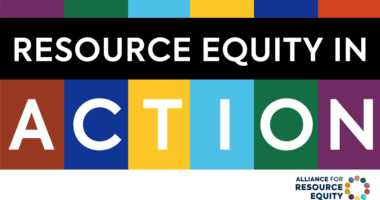A Time for Climate Action: Schools and the Inflation Reduction Act
Last fall, just as students were returning from summer break, schools across the nation were forced to close for “heat days.” The combination of excessive heat and inadequate infrastructure created school environments that were simply not safe or healthy places for students to learn. Unfortunately, school closures due to worsening heatwaves, flooding, wildfires, hurricanes, and more are no longer abnormal. Students, families, schools, and communities across the globe are living with the realities of our changing climate. But right now, schools in the U.S. have an unprecedented opportunity to be a part of the solution and create healthy, sustainable, and learning-ready environments where all students can thrive.
The Inflation Reduction Act (IRA) of 2022 offers a groundbreaking shift to support our country in reducing carbon pollution and transitioning to clean, renewable energy. With tax credits, financing, and grants, the IRA can support schools in installing solar panels, reducing annual energy costs, and can offset costs to switch from diesel buses to electric buses which will help students breathe cleaner air.
Our nation’s nearly 100,000 public schools represent one of the largest consumers of energy in the public sector, operate the largest mass transit fleet, and serve over 7 billion meals annually. Yet, until this point, large-scale climate solutions have not fully considered the role that education can play in advancing climate solutions — the IRA can help unlock the potential of the education sector in advancing climate solutions. Additionally, efforts to reduce carbon pollution from our schools can create opportunities for over 50 million students to engage with STEM solutions firsthand, ensuring that they are prepared to act in their communities and become leaders for a more sustainable future.
How can school leaders leverage the IRA for climate action?
The IRA offers an unprecedented opportunity for schools to take advantage of funds for projects that build climate resilience and reduce carbon pollution. For the first time, education leaders can leverage investment tax credits that recover up to 60% of the cost of installing clean energy systems, like solar or geothermal, in schools. Additionally, tax credits for clean transportation can be used to reduce the upfront cost of electric buses for schools — up to $40,000 per bus.
And, with the IRA’s recently introduced elective pay, or direct pay, provision, schools and other non-taxable organizations can access the tax credits as a cash payment directly from the IRS. These tax credits are non-competitive and uncapped, meaning that every school in the nation can benefit. Non-taxable entities will be required to undergo a pre-filing process prior to receiving the credit. The IRA’s Pre-Filing Registration Portal is now open.
The IRA also includes grant programs such as the Clean Heavy-Duty Vehicles Program to assist the transition from diesel school buses to electric school buses and the Funding to Address Air Pollution at Schools Program to help monitor and reduce greenhouse gas emissions in low-income and disadvantaged communities.
A Sustainable Future for All
While many students across the country will experience the effects of climate change, Black, Latino, Indigenous, other communities of color, as well as children and youth from under-resourced rural and urban communities, will be disproportionately impacted. In addition, under-resourced schools frequently pay more for annual maintenance and lack access to the capital needed for infrastructure projects. Prioritizing the implementation of IRA funds in under-resourced communities and those that will be most impacted by climate change can help address existing and future inequities.
The IRA’s impact on the education sector is not just about financial assistance; it is about igniting a crucial movement that shapes both educational systems and the climate landscape for generations to come. Communities, policymakers, and educators must unite to utilize IRA funding equitably to ensure a sustainable future for all our nation’s students. For more information on potential opportunities in the Inflation Reduction Act, please visit this resource, developed in partnership between The Aspen Institute’s This Is Planet Ed and the World Resources Institute’s Electric School Bus Initiative.
The responsibility for unlocking the funding offered by the IRA in an equitable manner is a collective effort, and everyone will have a role to play. This Is Planet Ed developed three toolkits to help parents, policymakers, and advocates navigate and utilize the IRA:
Michelle Faggert is a senior program associate for This Is Planet Ed at The Aspen Institute
Sophia Powless, This Is Planet Ed program coordinator, and Laura Schifter, This Is Planet Ed senior fellow, were coauthors of this article






